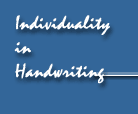The goal of research on questioned document examination is to develop an information processing model of handwriting examination so as to provide quantitative measures for several issues with legal implications, e.g., to what extent is handwriting individual? What is the error rate in determining whether two samples of unknown writership originated from the same writer? What is the error rate in determining the writership of a questioned document when there are n known writers? What is the relationship between error rate and the size/content of the questioned sample? Is the handwriting of chort groups any different than that of the general population? Is it possible to extract demographic information from handwriting? etc. An information processing model involves three components: a computational theory, a method of representation of writer information and an implementation to test the theory and representation. The computational theory would parallel both human cognitive skills and the methodology/expertise of expert practitioners. Representation involves algorithms that extract discriminating elements of handwriting from scanned handwritten documents. The implementation of the information processing model is a software realization. The testing of the model would be performed on handwriting samples obtained from both a representative population as well as well as from cohort groups. A software implementation, with user interfaces and quantitative measures of the strength of evidence, would be a useful tool for practitioners.
This research is a natural continuation of our earlier work on handwriting recognition. While the focus of recognition research is on extracting the message from the writing, the focus of questioned handwriting examination is the determination of writership.
Here we provide a glimpse of the research we are conducting through a description of our projects and our research papers.
Some derivatives of the work can be found in the following:
Download CEDAR-FOX software.
Download CEDARABIC software.




